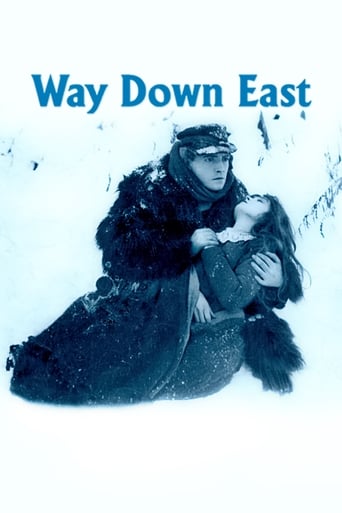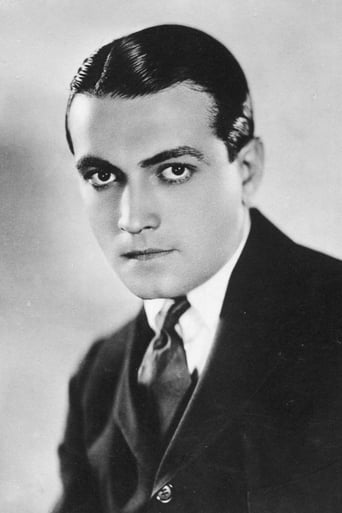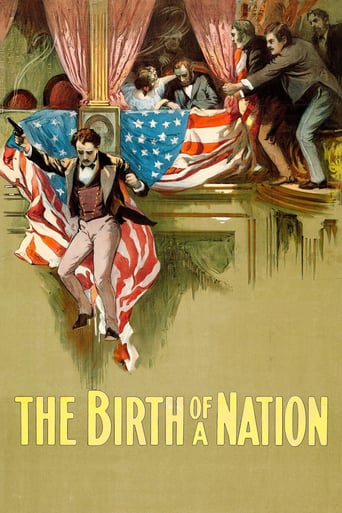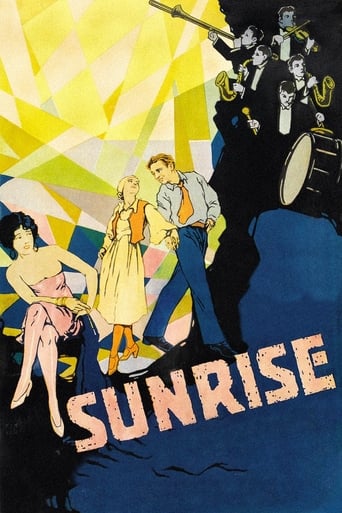Way Down East (1920)
A naive country girl is tricked into a sham marriage by a wealthy womanizer, then must rebuild her life despite the taint of having borne a child out of wedlock.
Watch Trailer
Cast


Similar titles
Reviews
Great movie! If you want to be entertained and have a few good laughs, see this movie. The music is also very good,
Good films always raise compelling questions, whether the format is fiction or documentary fact.
It’s sentimental, ridiculously long and only occasionally funny
The thing I enjoyed most about the film is the fact that it doesn't shy away from being a super-sized-cliche;
D.W. Griffith's lengthy silent melodrama about a naive young woman from the country who is taken advantage of by a cad. Later she finds love with a nice, sweet boy but her past comes back to haunt her. Never one to shy away from expressing his personal beliefs in his films, Griffith uses this simple story to sermonize about the moral character of men (basically they're all either doe-eyed innocents or total bastards) while also finding time to criticize the idle rich and prop up women as madonna figures. The opening title cards inform us men were never meant to be monogamous but we should try to be because Jesus said so...or something like that. Show that to your grandma's church group.Star Lillian Gish is terrific at expressing emotions with her face and body. Few actresses, silent era or since, have been able to convey so much without words. Then we have her performance in the climax. Watching Gish fling herself about in the ice and snow, knowing it caused permanent physical damage to her hand...well it's a disturbingly impressive dedication to one's craft. She really is one of the all-time greats. Babyfaced Richard Barthelmess and the rest of the cast are also good.On the negative side it is slow-going, particularly in the first half, with a lot of drawing room stuff and side visits through the local corn. As the film goes along, it becomes darker and more interesting, culminating in the justifiably famous snow storm finale with special effects provided by Mother Nature. Definitely worth a look for anyone who wants to see the best of the silent era, but I would advise against starting here. This is the type of film you need to be used to the silent movie pros & cons before attempting to watch it. That first hour or so is likely to drive away impatient viewers.
The film is overly long by at least a half hour, maybe even an hour. It drags. There are scenes with little or no merit. Subplots that distract the viewer.However, Gish's acting is superb. Her expressions carry us through the story. She provides us with the necessary character to hook onto and feel sympathy for. And, to be clear, Anna is a very interesting character.Charlotte Blair Parker's story, while I may disagree at times with the treatment, is fantastic. She weaves together a number of elements with some skill.Finally, I would be remiss if I didn't mention the, what appears to me to be, rather dangerous stunt work performed by the leads.Will it drag? Yes. But stick with it regardless for the good parts.
An old stage melodrama, written by Lottie Blair Parker and first performed around 1895, the story was old fashioned even in 1920. D. W. Griffith paid $175,000 for the film rights and a lot of people thought he was mad. As a film for his "muse", Lillian Gish, Griffith knew exactly what he was doing. He made the story seem so fresh and new and the "last minute rescue" on the ice wasn't found in the original play at all."A Simple Story of Plain People" was set in New England and Lillian Gish plays Anna Moore - the first scene she plays only with her expressive eyes and they show her every thought. It was truly wonderful acting. Anna is going to stay at her cousins, the Tremonts, in the hope that they will help her mother financially.She is allowed to dress for the Tremonts ball, although not invited to attend. An eccentric aunt (Florence Short) has other ideas and with a more alluring dress makes Anna the belle of the ball. Anna makes the acquaintance of Lennox Sanderson ( a very dapper Lowell Sherman), a wealthy womanizer, who determines to seduce Anna. He persuades her to agree to a secret marriage performed by a friend that he has paid, to impersonate a clergyman. Lillian Gish is so poignant and moving as Anna - at first so wide eyed and fluttering as an innocent country girl, then as the grieving young mother forced to baptise her own baby before it dies, she gives an spellbinding performance!!!She is forced to leave the lodgings because of gossip and the scene where she is trudging up the road, alone and forlorn, leaves a lump in your throat. She finds work at Squire Bartlett's (Burr McIntosh) residence, where she meets David (Richard Barthelmess). It seems Sanderson lives nearby and warns her to leave. David sees that she is upset and begs her to stay. She soon becomes a beloved member of the family, although the stern puritans know nothing of her past.The land lady from the lodging house visits the local sewing circle group, sees Anna passing and then tells all she knows about her which is quickly passed on to the Squire. He promptly turns Anna out into a raging snow storm and what a storm it was!!! The ice scene looked so real because it was. Clarine Seymour, originally given the role Mary Hay inherited, supposedly died from exposure to the almost artic conditions of the location. Lillian Gish recalls suggesting letting her arm and hair fall over the ice floe for dramatic effect and three weeks later she claimed her arm still felt like an icicle.It didn't originally receive praise from everyone - Alexander Woollcott from "The Screen" seemed to think the ice was papier mache and Robert Benchley from "Life" gave a slightly satirical review. They were both from 1920.I gave it 9 out of 10. I also agree it was slightly too long and there was a bit too much "unfunny" humour as well.Highly Recommended.
One of D.W. Griffith's last big commercial successes, 'Way Down East' represents much that was good in Griffith's directorial style and much that was wanting in it. Overall, it is a very solid movie and leaves the viewer satisfied in the end. It is certainly not the ideal film to show someone who has never watched a silent feature film, however.Anyone who has studied film history knows about the famous ice flow scene in which Lillian Gish put herself at tremendous risk in real-life blizzard conditions. This is the climax, but it comes only after a long and occasionally dragging journey.The lovely Ms. Gish plays Anna Moore, a naïve small town girl, tricked into a fake marriage by notorious womanizing playboy Lennox Sanderson (Lowell Sherman). Finding out about the sham only after telling Sanderson she is pregnant, she is abandoned and later evicted after both her mother and the baby die. Her past later catches up with her after she has established herself as a beloved maid in the Bartlett household, where son David (matinee idol Richard Barthlemess) is in love with her. It is when her past is revealed and Squire Bartlett (Burr McIntosh) throws her out into a blizzard that the famed ice flow sequence takes place.There are some faults in 'Way Down East.' It is long probably a bit longer than it needs to be. Plenty of time is spent in establishing the various characters, both major and minor, and the locales. There are a few spots where things seem to drag a bit. Of course Griffith strongly moralizes as usual, too. One fault that some critics have flagged that I do not necessarily agree with is Griffith's insertion of comedy relief. In many films of the era this did indeed mar films. In 'Way Down East,' though, the bumbling minor characters have a charm of their own and are naturally enough melded into the story that their actions do not seem to be at all intrusive to me. Vivia Ogden as the gossip Martha Perkins is quite good and her interaction with Seth Holcomb (Porter Strong), a goateed old goat who always seems to be at the Bartletts, is enjoyable. We are told Seth has followed her around for 20 years and she doesn't seem to mind his attention. Shy 'Professor' Creighton Hale is amusing at times, flirting clumsily with both Martha and the squire's niece Kate (Mary Hay.) Perhaps rolly polly hired hand Hi Holler (Edgar Nelson) could be dispensed with, but his screen time is limited and not a distraction. The music is at times heavy handed, but is appropriate in mood setting including the forays into comic relief.True, this is a potboiler melodrama with some heavy-handed Griffith preaching. Still, it also includes Griffith's famed build-up of intensity and speed as the climax is neared. It is also pictorially attractive, with snow-covered New England countrysides and landscapes. Also, Gish and Barthelmess never looked better. As other have noted, Gish by 1920 had fully come into her own as an actress and could make a very strong argument for being the best of all silent screen actresses.There are other silent films much easier to sit through in their entirety. This one is worth the effort, though. Griffith, warts and all, could tell a good story.













